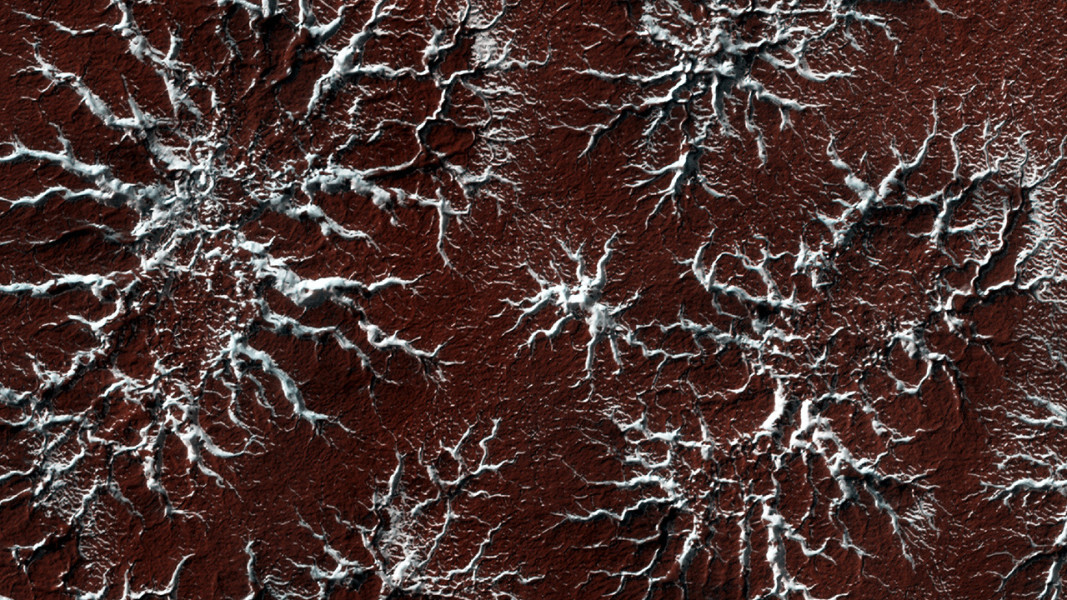8.09.2024

This image shows eroded channels near the Martian poles filled with bright frozen carbon dioxide, in contrast to the muted red of the underlying ground. In the summer the ice will disappear into the atmosphere, leaving just the channels of ghostly spiders carved in the surface.
Credit:NASA/JPL/University of Arizona
TUCSON, Ariz. – People have observed the bright Martian poles wax and wane for centuries, but only within the last 50 years have scientists discovered that they are mostly comprised of carbon dioxide cycling in and out of the atmosphere to the rhythm of the seasons. But exactly how this happens is a complex interplay of planetary processes that scientists are continually teasing out.
PSI Senior Scientist Candice Hansen leads a new paper published in Icarus that weaves together decades of past research with more recent observations collected by the High-Resolution Imaging Experiment, or HiRISE, instrument on the Mars Reconnaissance Orbiter to compare how the Martian poles differ in their seasonal uptake and release of carbon dioxide.
“Everybody knows there’s a difference in how carbon dioxide interacts with the poles, but how many people understand why?” Hansen said. “That was what I was setting out to describe. And fortunately, I have a whole bunch of really talented co-authors who were willing to fill in their own pieces.”
The goal was to shed light on the processes that shape the planet’s surface as well as Mars’ overall climate – since Mars cycles about a quarter of its atmosphere throughout the Martian year.
Like Earth, Mars spins at a tilt of about 25 degrees, so it experiences seasons, but Mars’ much longer path around the Sun is also more oblong – or what scientists call eccentric – than Earth’s.
If Mars’ path around the Sun was a perfect circle, then all of its seasons would be equally long. But its eccentricity situates Mars farthest from the Sun during southern fall and winter – which is simultaneously northern spring and summer – meaning these seasons for each hemisphere are the longest for the planet. Mars’ southern hemisphere is also significantly more elevated than the northern hemisphere.
“So ultimately, southern fall and winter bring the most freezing and lowest atmospheric pressure,” since so much of the atmosphere is frozen as dry ice, Hansen said. “These are the major drivers of differences in seasonal behavior of carbon dioxide between the hemispheres.”
Mars’ northern winter, by contrast, is not only shorter than southern winter, but it also coincides with dust storm season. As a result, the northern polar seasonal cap contains a higher concentration of dust than the south polar cap, making the ice less robust.
“They’re not symmetric seasons,” Hansen said.
Differences in the northern and southern polar terrains also impact how carbon dioxide ice and gas shape the landscape, according to the paper.
For example, in the southern hemisphere, black dust fans are distributed across the landscape.
“A layer of carbon dioxide ice builds in the southern hemisphere fall, and over the course of the winter, it thickens and it becomes translucent,” Hansen said. “Then in the spring, the sun comes up, and light penetrates this ice layer to the bottom enough that it warms up the ground underneath.”
The warm ground then turns the carbon dioxide ice into gas, a process called sublimation.
“Now, gas is trapped under pressure,” Hansen said. “It’s going to look for any weak spot in the ice and rupture like a champagne cork.”
As soon as it finds a weak spot, the ice ruptures and gas rushes over to the break, carving at the surface along the way, creating a network of gully channels that splay out across the landscape. These are called araneiforms because of their spider-like appearance.
Once the gas breaks through the ice, it blows dark dust into the atmosphere.
“It turns out that meteorology is really important in this picture too, because from there, the dust is blown by whatever wind happens to be present and lands in a fan-shaped deposit,” Hansen said.

Geophysicist Hugh Kieffer described that process in 2006. A few years later, Hansen followed up with her own model for the north polar cap, which also displays fans in the spring.
She found that the same phenomena occur in the north, but rather than relatively flat terrain, these processes play out across sand dunes.
“When the Sun comes up and begins to sublimate the bottom of the ice layer, there are three weak spots – one at the crest of the dune, one at the bottom of the dune where it meets the surface and then the ice itself can crack along the slope,” Hansen said. “No araneiform terrain has been detected in the north because although shallow furrows develop, the wind smooths the sand on the dunes.”

As a member of the HiRISE imaging team, Hansen sees changes on the Martian surface over the course of years, months, even days.
“Most of my colleagues study the changes that happened on Mars 3.5 billion years ago, but I’m talking about things that happened last month,” Hansen said. “Mars is active today.”
Hansen’s work is supported by the Mars Reconnaissance Orbiter Mission’s HiRISE instrument through a subcontract from the University of Arizona.
Quelle: THE PLANETARY SCIENCE INSTITUTE
